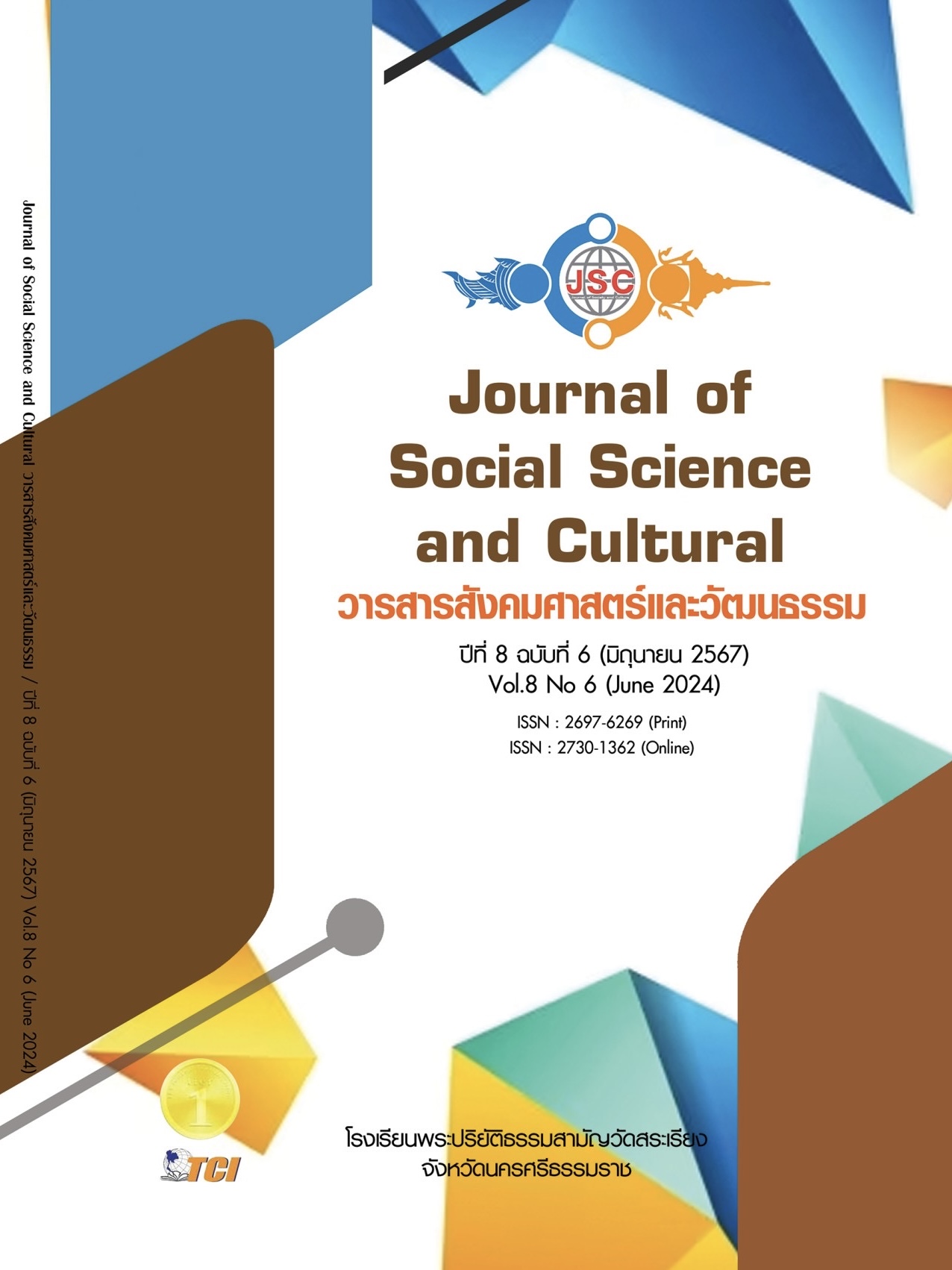A STUDY OF THE EMOTIONAL INTELLIGENCE ON YOUTH IN SUPHANBURI PROVIENCE
Main Article Content
Abstract
The purposes of this study were to: 1) study the emotional intelligence of youth in Suphanburi Province and 2) compare the emotional intelligence of youth in Suphanburi Province. This research is a quantitativeresearch. The sample group was youth aged between 12-17 years old in Suphan Buri Province, totaling 1,000 people with a simple sampling method. The instruments used to collect data were Emotional Intelligence Test for teenagers aged 12-17 years. The data were analyzed by mean, standard deviation, t-test, and ANOVA. This research has set the significance level at the .05 level. The data will be presented in the form of a table accompanying the essay. The research results found that: 1) Emotional intelligence of youth in Suphanburi Province, all three aspects consist of three sub-aspects: 1) good side, 1.1) self-control = 17.96, 1.2) Sympathy for others = 18.80, 1.3) responsibility = 19.35, 2) the skill side consists of 3 sub-sides: 2.1) motivation = 16.80, 2.2) decision making and problem solving = 16.22, 2.3) relationships = 16.00 and 3) the happiness side consists of 3 sub-sides: 3.1) self-esteem = 10.89, 3.2) satisfaction with life = 18.10, 3.3) happiness and peace of mind. =17.33 by all aspects of emotional intelligence and all sub-aspects within the range of normal scores.; 2) Comparing the emotional intelligence of youth in Suphanburi Province, it was found that there were differences in gender, age, and educational level. And the different residential districts, it was found that the differences in emotional intelligence were statistically significant at the .05 level.
Article Details
References
กรมกิจการเด็กและเยาวชน กระทรวงพัฒนาสังคมและความมั่นคงของมนุษย์. (2565). สถิติข้อมูลและสถานการณ์ ด้านเด็กและเยาวชน ประจำปี 2565. เรียกใช้เมื่อ 29 เมษายน 2567 จาก https://www.dcy.go.th/public/mainWeb/file_download/1686102604925-826861114.pdf
กรมสุขภาพจิต. (2543). คู่มือความฉลาดทางอารมณ์. กรุงเทพมหานคร: ชุมชนสหกรณ์การเกษตรแห่งประเทศไทย.
กรมสุขภาพจิต. (2544). รายงานวิจัยการพัฒนาแบบประเมินความฉลาดทางอารมณ์สำหรับประชาชนไทย อายุ12-60 ปี. นนท์บุรี: สำนักพิมพ์วงศ์กมลโปรดักชั่น.
กระทรวงศึกษาธิการ. (2562). พระราชบัญญัติการศึกษา (ฉบับที่ 4) พ.ศ. 2562. เรียกใช้เมื่อ 29 เมษายน 2567 จาก https://www.moe.go.th/wp-content/uploads/2022/01/MOE-Authority.pdf
ชิสาพัชร์ ชูทอง. (2560). การศึกษาความฉลาดทางอารมณ์ของนักศึกษาระดับปริญญาตรีที่ศึกษาในรายวิชาวิทยาศาสตร์ในชีวิตประจำวัน. ใน การประชุมวิชาการระดับชาติ ครั้งที่ 4. มหาวิทยาลัยราชภัฏเพชรบูรณ์.
ถนอมศักดิ์ จิรายุสวัสดิ์. (2556). EQ ดีทำอะไรก็สำเร็จ. กรุงเทพมหานคร: สำนักพิมพ์ปราชญ์.
เทพสงวน กิตติพันธุ์. (2560). การควบคุมอารมณ์. เรียกใช้เมื่อ 29 เมษายน 2567 จาก http://www.stou.ac.th/Offices/rdec/udon/upload/socities3_4.html
นิภาพร อางควนิช และคณะ. (2561). อิทธิพลของความแตกต่างระหว่างเพศและบุคลิกภาพที่มีต่อคำภาษาไทยและเสียงดิจิทัลที่เร้าอารมณ์ด้านการมีอิทธิพลในผู้ใหญ่ตอนต้น: การศึกษาเชิงพฤติกรรม. วารสารวิชาการ มหาวิทยาลัยกรุงเทพธนบุรี, 7(2), 203-216.
ยรรยง คชรัตน์ และคณะ. (2557). ความฉลาดทางอารมณ์ของนักศึกษาระดับปริญญาตรี ชั้นปีที่ 1 ในพื้นที่จังหวัดชายแดนใต้. ใน การประชุมหาดใหญ่ วิชาการระดับชาติและนานาชาติ ครั้งที่ 7. มหาวิทยาลัยหาดใหญ่.
สำนักงานบริหารการทะเบียน กรมการปกครอง กระทรวงมหาดไทย. (2564). ระบบสถิติการลงทะเบียน. เรียกใช้เมื่อ 29 เมษายน 2567 จาก https://stat.bora.dopa.go.th/stat/statnew/statyear/#/TableTemplate3/Area/statpop.
สำนักงานศึกษาธิการจังหวัดสุพรรณบุรี. (2566). แผนพัฒนาการศึกษาจังหวัดสุพรรณบุรี ระยะ 5 ปี (พ.ศ.2566-2570). เรียกใช้เมื่อ 29 เมษายน 2567 จาก https://drive.google.com/file/d/1Q6S7MbY0_4KNHg6ytRH_qJIbKMGJ4ZLJ/view.
Cochran, W. G. (1977). Sampling Techniques (3rd ed.). New York: John Wiley & Sons.
Filkowski, M. M. et al. (2017). Sex differences in emotional perception: meta analysis of divergent activation. Neuro Image, 15(147), 925-933.


